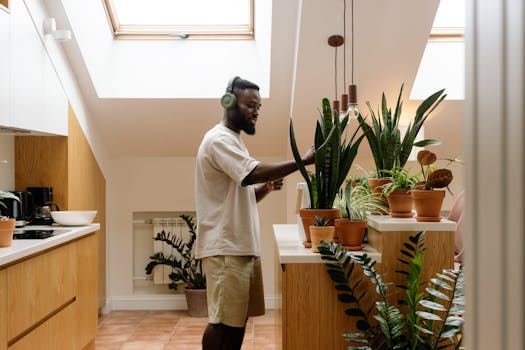Attracting Pollinators to Your Garden: Stress-Relieving Techniques and the Best Plants for a Wildlife Haven
- Water Sources: Ensure your garden has accessible water sources, such as shallow dishes or birdbaths. Pollinators need water, and providing it can encourage them to visit your garden more frequently.
By following these tips, you can cultivate a thriving garden that contributes to the well-being of both pollinators and yourself.
Plant Placement: When planting, group flowers in clusters. This makes it easier for pollinators to find them. Try to plant in blocks of the same type of flower. Imagine a buffet for bees—it’s much more inviting when everything is in one place!
Include Native Plants: Native plants are well-suited to your local climate and soil. They require less water and maintenance than non-native species. Native plants also attract local pollinators, which are accustomed to them.
Add Water Sources: Pollinators need water to survive. Create a small water source, like a birdbath with pebbles for landing spots. This will keep your pollinator friends happy and hydrated.
A successful pollinator garden not only attracts wildlife but also enhances your outdoor space. For example, consider the case of a family who transformed their small backyard into a vibrant pollinator haven. They began by planting various native flowers and adding a small water feature. Within weeks, they noticed bees, butterflies, and even birds flocking to their garden. Their children loved watching the wildlife, and the family enjoyed relaxing in their beautiful, peaceful space.

Overcoming Common Challenges in Gardening for Pollinators
Gardening can come with its own set of challenges. Here are some common issues and solutions to help you maintain a thriving pollinator garden:
Pests: Insects can sometimes wreak havoc on your plants. Instead of reaching for harmful chemicals, consider using natural remedies. For example, sprinkle diatomaceous earth around your plants. This natural powder can deter pests without harming beneficial insects. For more comprehensive pest management, look into best organic pest control methods.
Plant Diseases: To prevent diseases, ensure good air circulation around your plants. Avoid overcrowding and regularly check for signs of disease. If you notice any issues, remove affected plants immediately to prevent spreading.
Poor Soil Quality: If your soil is lacking nutrients, consider using organic fertilizers. Compost is an excellent choice and enriches the soil. You can make your own compost from kitchen scraps and yard waste, turning waste into a valuable resource.
Adapting to Climate: Different plants thrive in different climates. Research plants that are native to your area, as they are more likely to succeed. If you live in a dry climate, choose drought-resistant plants. For cooler climates, look for hardy species that can withstand frost.
Gardening doesn’t have to be overwhelming. By addressing these common challenges with simple, eco-friendly solutions, you can create a healthy environment for both your plants and the pollinators that rely on them. (Plus, you’ll feel like a gardening superhero when you solve these problems!)

FAQs
Q: How can I create a pollinator-friendly garden layout that supports diverse species throughout the seasons?
A: To create a pollinator-friendly garden layout, incorporate a variety of native plants that bloom at different times throughout the seasons, ensuring continuous food sources for pollinators. Include simple flowers rich in nectar and pollen, avoid double flowers, and create diverse habitats with nesting sites and shelter to support various species.
Q: What are some lesser-known plant species that are particularly effective at attracting a wide range of pollinators in a wildlife garden?
A: Some lesser-known plant species that are effective at attracting a wide range of pollinators include the blue-flowered borage (Borago officinalis), which attracts bees and butterflies, and the evening primrose (Oenothera biennis), which is favored by nocturnal pollinators like moths. Additionally, the native milkweed (Asclepias spp.) is crucial for attracting monarch butterflies and other beneficial insects.
Q: How do I manage pest control in my garden without harming beneficial pollinators?
A: To manage pest control in your garden without harming beneficial pollinators, use integrated pest management (IPM) techniques that focus on biological controls, such as attracting birds and beneficial insects, and employ physical barriers like insect mesh. Opt for horticultural soaps and oils instead of chemical pesticides, and encourage a diverse plant community to naturally deter pests.
Q: Can you suggest strategies for maintaining a consistent source of water and shelter to support pollinators year-round?
A: To maintain a consistent source of water for pollinators year-round, consider installing a pond or water feature with shallow edges and native plants, ensuring it is well-planted for habitat. For shelter, create diverse habitats by incorporating native plants, leaving areas of undisturbed soil for ground-nesting bees, and providing simple nesting sites using bundles of drinking straws or twigs.
Q: How can I enhance my garden to create a unique butterfly haven?
A: To enhance your garden for butterflies, consider adding specific plants that attract these pollinators. Incorporate nectar-rich flowers and host plants for caterpillars, ensuring a vibrant and inviting environment. For more comprehensive insights, refer to our unique butterfly haven guide.
